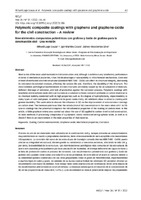Polymeric composite coatings with graphene and graphene oxide for the civil construction – A review
Date
2021-11-05Author
Lage Souza, Rithyeli
Martins Coura, Igor
Nicodemos Silva, Sidney
Metadata
Show full item recordAbstract
Steel is one of the most used materials in civil construction and, although it exhibits a very satisfactory performance in terms of mechanical properties, it has the disadvantage of susceptibility to tribochemical mechanisms. Corrosion of steel of reinforced concrete structures (Standard NBR 7480 - CA50) can affect its structural integrity, decreasing its resistance to external stresses, affecting the service life and, therefore, the durability of the structure. The most common pathological manifestations in steel structures are mainly caused by the accumulation of moisture, deficient drainage of rainwater, and lack of protection against the corrosion process. Polymeric coatings with Graphene and Graphene oxide (GO) can be seen as a solution to these corrosion problems in carbon steel due to its chemical stability combined with its high properties such as the degree of hydrophobicity, impermeability to many types of salts and gases, in addition to its good conductivity, GO additions allow to obtain a coating with greater durability. This work aims to discuss the influence of GO on the improvement of anti-corrosion coatings on carbon steel. The literature points out that the introduction of GO concentration in the mass ratios of 0.1 to 5% w/w in coatings has the potential to improve the tribochemical properties of the coating on carbon steel. In this article, a bibliographical review was carried out about the use of GO applied to carbon steel in civil construction, its main methods of processing composites of a polymeric matrix reinforced with graphene oxide, as well as to check if there is an improvement in the main properties of that material. El acero es uno de los materiales más utilizados en la construcción civil y, aunque presenta un comportamiento muy satisfactorio en cuanto a propiedades mecánicas, tiene el inconveniente de ser susceptible a los mecanismos triboquímicos. La corrosión del acero de las estructuras de hormigón armado (Norma NBR 7480 - CA50) puede afectar su integridad estructural, disminuyendo su resistencia a tensiones externas, afectando la vida útil y, por tanto, la durabilidad de la estructura. Las manifestaciones patológicas más comunes en las estructuras de acero son causadas principalmente por la acumulación de humedad, el drenaje deficiente del agua de lluvia y la falta de protección contra el proceso de corrosión. Los recubrimientos poliméricos con grafeno y óxido de grafeno (GO) pueden verse como una solución a estos problemas de corrosión en el acero al carbono debido a su estabilidad química combinada con sus altas propiedades como el grado de hidrofobicidad, impermeabilidad a muchos tipos de sales y gases, en Además de su buena conductividad, las adiciones GO permiten obtener un recubrimiento con mayor durabilidad. Este trabajo tiene como objetivo discutir la influencia de GO en la mejora de los recubrimientos anticorrosión en acero al carbono. La literatura señala que la introducción de la concentración de GO en las proporciones de masa de 0,1 a 5% p / p en revestimientos tiene el potencial de mejorar las propiedades triboquímicas del revestimiento sobre acero al carbono. En este artículo se realizó una revisión bibliográfica sobre el uso de GO aplicado al acero al carbono en la construcción civil, sus principales métodos de procesamiento de composites de matriz polimérica reforzada con óxido de grafeno, así como comprobar si existe una mejora en el principales propiedades de ese material.
Collections
The following license files are associated with this item:



